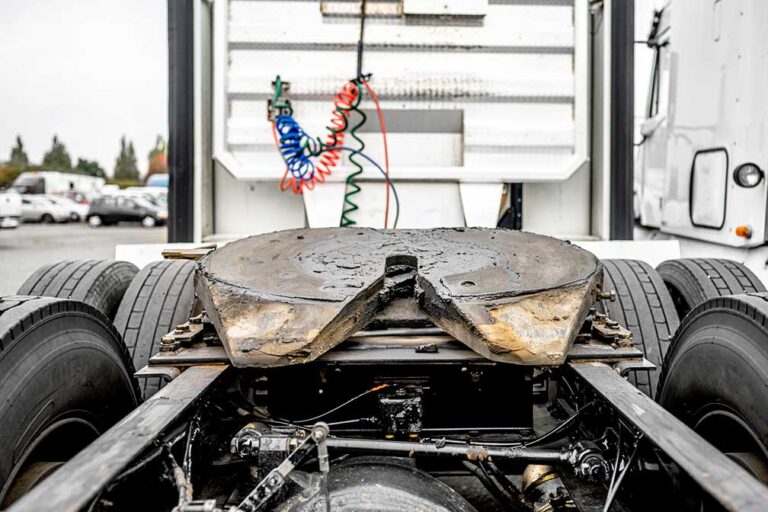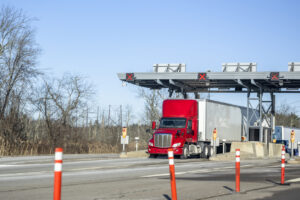The photos were stark. On March 1, 2024, a chain-reaction crash on the Clark Memorial Bridge in Louisville, Kentucky, resulted in the driver of a passenger vehicle crossing the centerline and hitting a commercial semi.
The tractor, which was hauling a refrigerated trailer, lost control and broke through the guardrail. The trailer was caught in the bridge’s superstructure, with about half of its length protruding through the railing. The cab of the truck, dangling above the Ohio River far below, secured only by the trailer’s kingpin connection with the tractor.
The driver was rescued, the wreckage removed and the bridge reopened. There were plenty of thanks to go around — to the police and fire departments who responded, the EMT who was lowered by crane to retrieve the driver, and to others.
The unsung hero in this story, however, is not a person or an emergency response agency. That hero is the 1.5-inch steel kingpin, and the tractor’s fifth wheel that gripped the kingpin, holding the cab in place until a rescue could be performed.
The fifth wheel is one of the most important parts of a truck — and it’s often the most neglected.
The Louisville accident was a dramatic example of the fifth-wheel’s capability. This device does much more than prevent the tractor and trailer from separating. Fifth wheels impact a tractor-trailer’s weight distribution, vehicle ride and even helps (or hinders) safe steering.
Don’t skip proper fifth-wheel maintenance.
Many drivers don’t give much thought to the fifth wheel on their tractor, other than to periodically slather on a blob of grease. But there’s a methodology to that process too — one that can result in equipment damage or failure if it isn’t followed.
To properly lubricate a fifth wheel, the locking jaws must be open. (That’s usually the case anyway once the truck is disconnected from the trailer.) The surface of the fifth wheel, especially around the jaws, should be thoroughly cleaned before lubricating. Cracks in the steel can be hidden by grease and dirt, and the inspector might not notice them.
Lubricant should be applied lightly. Spread a thin layer over the fifth-wheel surface and onto the apron. Excess grease attracts dirt, and dirt captured within the grease can act like sandpaper as the trailer grinds it downward during turns. That means extra wear and tear on the surfaces.
Keep in mind that the jaws of the fifth wheel can’t be properly inspected while they’re open. You can use a pry bar or pipe to close them so they can be inspected for cracks. The jaws should also be lubricated with grease, never oil. Spread the grease by pulling the fifth wheel release handle partway out and releasing. Don’t pull it out far enough to lock the jaws open; everything should operate smoothly.
Some drivers prefer to use 90-weight gear oil or even diesel fuel to lubricate the jaws. However, these substances will wear off much faster than grease and aren’t recommended by any manufacturer.
While inspecting your fifth wheel, it’s important to check as many parts as you can see. The release handle should be straight, with the mounting brackets solidly bolted to the frame with no evidence of loose bolts or cracks. Rust stains around bolts can indicate loosening, so have the bolts checked for proper torque if rust is present.
If the fifth wheel is adjustable, check the brackets, air lines and cylinder for cracks, leaks and other issues. Any springs that can be accessed should be checked, as well as any parts of the fifth wheel that can be accessed.
Inspect the entire fifth wheel for damage caused by the kingpin striking the surface during coupling. When the tractor and trailer aren’t perfectly aligned, damage can result from the pin striking the fifth-wheel surface, the truck frame or other components.
The adjustment knob on the side of the fifth wheel is a mystery to many drivers. When connected to a kingpin, there should be a small amount of play in the adjustment rod. If the adjustment rod can’t be pushed in slightly (a quarter of an inch or less), it should be checked by a technician. The adjustment rod is designed to compensate for kingpins that may be worn and aren’t their full diameter.
Proper alignment can help prevent damage.
As referenced earlier, it’s important to make sure the fifth wheel and the trailer kingpin are properly aligned when coupling with a trailer. The “V” shape of the slot in the fifth wheel apron will help correct side-to-side alignment issues, but not height issues. The landing gear on the trailer can be used to adjust the trailer height, or the airbags on the tractor can be released to lower the tractor.
While the trailer is disconnected and the fifth wheel exposed, apply a small amount of grease, if necessary, and take a quick look for cracks or anything else that doesn’t look right.
Often, drivers attempt to correct misalignment problems with horsepower, assuming that forcing the tractor back will raise the trailer and connect the jaws and kingpin. Sometimes this strategy works, but it can also cause damage to the components. The other extreme is a trailer that’s too high, causing the kingpin to ride up over the fifth wheel and possibly allowing the front of the trailer to contact the back of the cab.
For that reason, it’s important to visually check alignment before fully backing under the trailer. Stop, apply the parking brakes, get out and take a look. Bring a flashlight and get under the trailer, checking to make sure the kingpin is directly in line with the jaws of the fifth wheel and that the trailer will be lifted slightly as the fifth wheel slides underneath.
With the driver’s window open, back up until you hear the solid “clunk” of the fifth wheel jaws closing around the kingpin. Then put the tractor in a forward gear and perform a gentle “tug” test. Finally, take your flashlight and visually verify that the fifth wheel jaws are fully closed. It’s possible they’re only partially closed, or that they’ve closed around the wrong part of the kingpin. This could potentially result in a failure down the road.
Every driver depends on the fifth wheel for safety and performance. Don’t leave it to chance — instead, regularly inspect and lube this critical device.
Cliff Abbott is an experienced commercial vehicle driver and owner-operator who still holds a CDL in his home state of Alabama. In nearly 40 years in trucking, he’s been an instructor and trainer and has managed safety and recruiting operations for several carriers. Having never lost his love of the road, Cliff has written a book and hundreds of songs and has been writing for The Trucker for more than a decade.














